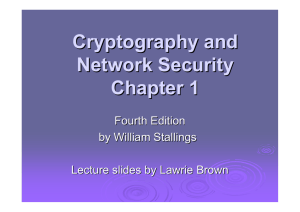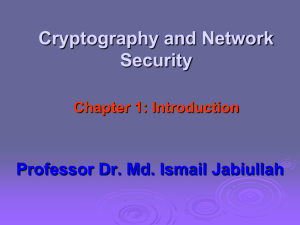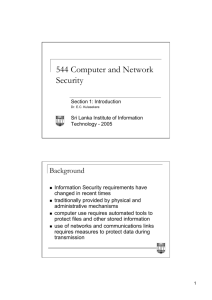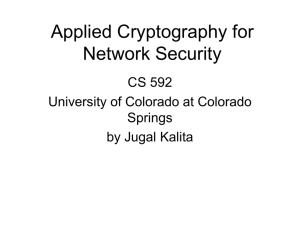(x,x') = x' - University of California, Berkeley
advertisement
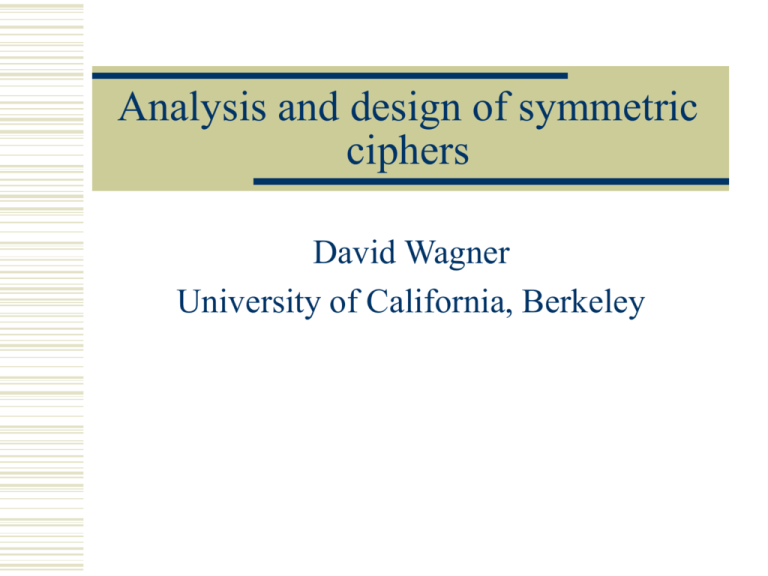
Analysis and design of symmetric ciphers David Wagner University of California, Berkeley What’s a block cipher? x Ek : X → X k Ek(x) bijective for all k When is a block cipher secure? Answer: when these two black boxes are indistinguishable. k x x E block Ek(x) cipher random (x) permutation Example: The AES 4×4 matrix 4×4 matrix 4×4 matrix 4×4 matrix byte re-ordering S(x) = l(l’(x)-1) in GF(28), where l,l’ are GF(2)-linear and the MDS matrix and byte re-ordering are GF(28)-linear One round S S S S S S S S S S S S S S S S In this talk: How do we tell if a block cipher is secure? How do we design good ones? Survey of cryptanalysis of block ciphers Steps towards a unifying view of this field Algebraic attacks How to attack a product cipher X X f1 X Ek = X fn X X 1. Identify local properties of its round functions 2. Piece these together into global properties of the whole cipher Motif #1: projection Identify local properties using commutative diagrams: X Y fk gk’ ’ X Y where: fk = original round function gk’ = reduced round function and: gk’ ○ = ’ ○ fk Concatenating local properties Build global commutative diagrams out of local ones: X X f1 X ’ Y X g1 Y + f2 X ’ ” Y f1 g1 Y g2 Y X = ’ Y f2 g2 X ” Y Exploiting global properties Use global properties to build a known-text attack: X The distinguisher: Y Ek g ’ X Y Let (x, y) be a plaintext/ciphertext pair If g((x)) =’(y), it’s probably from Ek Otherwise, it’s from Example: linearity in Madryga Madryga leaves parity unchanged GF(2)64 Let (x) = parity of x We see (Ek(x)) = (x) GF(2)64 f1 GF(2) id GF(2) This yields a distinguisher Pr[((x)) = (x)] = ½ Pr[(Ek(x)) = (x)] = 1 GF(2)64 fn GF(2)64 GF(2) id GF(2) Motif #2: statistics Suffices to find a property that holds with large enough probability X Prob. p Ek Maybe probabilistic commutative diagrams? Y g ’ X Y where p = Pr[’(Ek(x)) = g((x))] A better formulation? Stochastic comm. diagrams X Ek , , ’ induce a stochastic process M (hopefully Markov); , Ek , ’ yield M’ X Pick a distance measure d(M, M’), say 1/||M(x) – M’(x)||2 where the X r.v. x is uniform on X Then d(M,M’) known texts suffice to distinguish Ek from X Y M ’ Y Y M’ ’ Y Example: Linear cryptanalysis Matsui’s linear cryptanalysis Set X = GF(2)64, Y = GF(2) Cryptanalyst chooses linear maps , ’ cleverly to make d(M,M’) as small as possible Then M is a 2×2 matrix of the form shown here, and 1/2 known texts break the cipher X Y Ek M ’ X [ M = Y ] ½+ ½– ½– ½+ and d(M, M’) = 1/2 Motif #3: higher-order attacks Use many encryptions to find better properties: X ×X Y Êk X ×X M ’ Y Here we’ve defined Êk(x,x’) = (Ek(x), Ek(x’)) Example: Complementation Complementation properties are a simple example: X ×X Êk X ×X Take (x,x’) = x’ – x Suppose M(Δ,Δ) = 1 for M some cleverly chosen Δ Then we obtain a X complementation property X Exploit with chosen texts Example: Differential crypt. Differential cryptanalysis: X ×X Êk X ×X Set X = GF(2)n, and take (x,x’) = x’ – x M If p = M(Δ,Δ’) » 0 for some clever choice of Δ, Δ’: X can distinguish with 2/p chosen plaintexts X Example: Impossible diff.’s Impossible differential cryptanalysis: X ×X Êk X ×X Set X = GF(2)n, and take (x,x’) = x’ – x M If M(Δ,Δ’) = 0 for some clever choice of Δ, Δ’: X can distinguish with 2/M’(Δ,Δ’) known texts X Example: Truncated diff. crypt. Truncated differential cryptanalysis: X ×X 1 Êk X ×X 2 Set X = GF(2)n, Y = GF(2)m, Y cleverly choose linear maps φ1, φ2 : X → Y, and take M i(x,x’) = φi(x’ – x) If M(Δ,Δ’) » 0 for some Y clever choice of Δ, Δ’, we can distinguish Generalized truncated d.c. Generalized truncated differential cryptanalysis: X ×X 1 Êk X ×X 2 Take X, Yi, i as before; then Y1 = maxx ||M(x) – M’(x)|| measures the distinguishing M power of the attack Generalizes the other attacks Y2 The attacks, compared generalized truncated diff. crypt. truncated d.c. l.c. with multiple approximations differential crypt. impossible d.c. linear crypt. complementation props. linear factors Summary (1) A few leitmotifs generate many known attacks Many other attack methods can also be viewed this way (higherorder d.c., slide attacks, mod n attacks, d.c. over other groups, diff.linear attacks, algebraic attacks, etc.) Are there other powerful attacks in this space? Can we prove security against all commutative diagram attacks? We’re primarily exploiting linearities in ciphers E.g., the closure properties of GL(Y, Y) Perm(X) Are there other subgroups with useful closure properties? Are there interesting “non-linear’’ attacks? Can we prove security against all “linear” comm. diagram attacks? Part 2: Algebraic attacks Example: Interpolation attacks Express cipher as a polynomial in the message & key: id X X Ek p id X X Write Ek(x) = p(x), then interpolate from known texts Or, p’(Ek(x)) = p(x) Generalization: probabilistic interpolation attacks Noisy polynomial reconstruction, decoding Reed-Muller codes Example: Rational inter. attacks Express the cipher as a rational polynomial: id X Ek id X If Ek(x) = p(x)/q(x), then: Write Ek(x)×q(x) = p(x), and apply linear algebra p/q Note: rational poly’s are closed under composition X Are probabilistic rational interpolation attacks feasible? X A generalization: resultants A possible direction: bivariate polynomials: X f1 p1 X p2 X X f2 X The small diagrams commute if pi(x, fi(x)) = 0 for all x Small diagrams can be composed to obtain q(x, f2(f1(x))) = 0, where q(x,z) = resy(p1(x,y), p2(y,z)) Some details not worked out... Algebraic attacks, compared probabilistic bivariate attacks prob. rational interpol. bivariate attacks probabilistic interpol. rational interpol. MITM interpolation interpolation attacks Summary Many cryptanalytic methods can be understood using only a few basic ideas Commutative diagrams as a unifying theme? Algebraic attacks of growing importance Collaboration between cryptographic and mathematical communities might prove fruitful here
